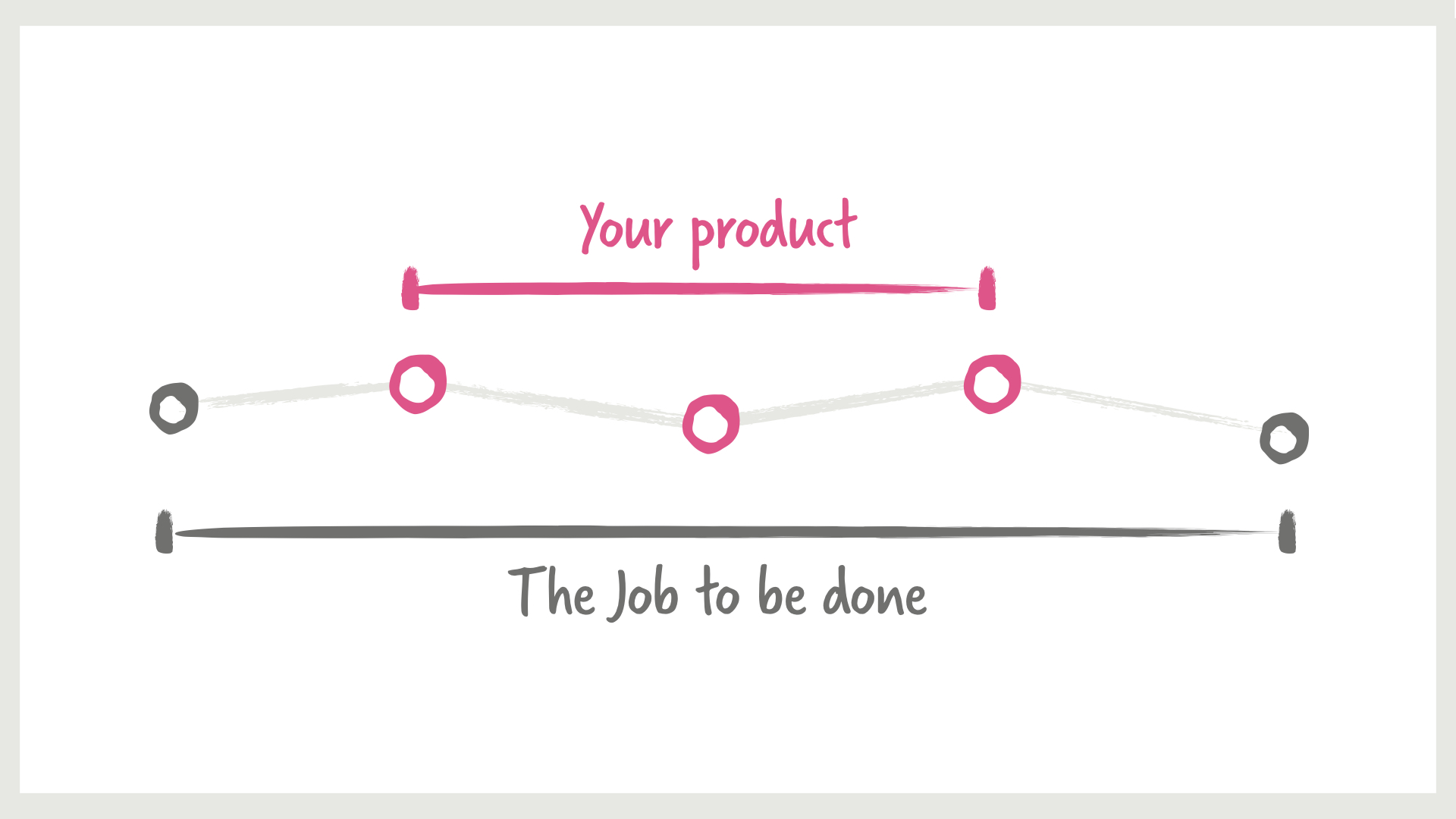The Core Tenets of JTBD Theory
- People buy products and services to get a “job” done.
- Jobs are functional, with emotional and social components.
- A Job-to-be-Done is stable over time.
- A Job-to-be-Done is solution agnostic.
- Success comes from making the “job”, rather than the product or the customer, the unit of analysis.
- A deep understanding of the customer’s “job” makes marketing more effective and innovation far more predictable.
- People want products and services that will help them get a job done better and/or more cheaply
- People seek out products and services that enable them to get the entire job done on a single platform
- Innovation becomes predictable when “needs” are defined as the metrics customers use to measure success when getting the job done
So… What is JTBD?
As defined by the pioneers:
Jobs-to-be-Done is best defined as a perspective — a lens through which you can observe markets, customers, needs, competitors, and customer segments differently, and by doing so, make innovation far more predictable and profitable.
People don’t simply buy products or services; they pull them into their lives to make progress. We call this progress the “job” they are trying to get done, and understanding this opens a world of innovation possibilities.
JTBD Frameworks
While the theoretical foundations are generally agreed upon, things differ when it comes to practical applications of Jobs to be Done tools and techniques. There are two primary schools of thought:
Two approaches:
- Switch (Bob Moesta and Chris Spiek, working with Clayton Christensen)
- ODI: Outcome-Driven Innovation® (Anthony Ulwick, Strategyn LLC)
I can’t tell you which approach is the right fit for you, but I would urge you to study both and cherrypick the tools and techniques that fit your team and way of working.
The Job Story format
When _______ [context],
I want to ________ [motivation],
So I can _________ (desired outcome)
Origin of Job Stories:
- How we accidentally invented Job Stories, Paul Adams, Intercom
- Designing features using Job Stories, Alan Klement, Intercom
A Job Story is a great way to introduce demand thinking to your team and coworkers, as both a workshop/intro tool, and as a format to keep insights visible over time.
Read the accompanying blog post: Intro to Job Stories.
Benefits of working with Jobs to be Done
In my experience, Jobs Theory, and its associated frameworks, is universally applicable and highly useful, because it provides the models that we use to create:
Sticky Insights: Make data reliable and understand demand for our products
Common Goals: Low risk and high potential
Shared Language: Eliminate waste and empower people
Read on to find all of the resources I’ve gathered from studying and applying JTBD thinking since 2012:
Deep dives into JTBD
Essential Reads
- Turn Customer Input into Innovation
Anthony W. Ulwick
Harvard Business Review, January 2002 - Marketing Malpractice: The Cause and the Cure
Clayton M. Christensen, Scott Cook and Taddy Hall
Harvard Business Review, December 2005 - Finding the Right Job For Your Product
Clayton M. Christensen, Scott D. Anthony, Gerald Berstell and Denise Nitterhouse
MIT Sloan Management Review, April 2007 - Giving Customers a Fair Hearing
Anthony W. Ulwick
MIT Sloan Management Review, April 2008 - The Customer-Centered Innovation Map
Lance Bettencourt and Anthony W. Ulwick
Harvard Business Review, May 2008 - Know Your Customers’ “Jobs to Be Done”
Clayton M. Christensen, Taddy Hall, Karen Dillon and David S. Duncan
Harvard Business Review, September 2016
Two presentations, by Andrei Radulescu, that bring together ODI and Switch to bridge the perceived gap between these JTBD schools:
What Is Jobs-To-Be-Done?, makes the case for Jobs-To-Be-Done and brings to life its theoretical foundations using two illustrations and a case study.
Intro to JTBD, discusses application areas, research methods, and takes a deeper, more abstract look, at the theoretical foundations.
Books on JTBD



Videos on JTBD
Articles on JTBD
- What is Jobs to be Done?, Justin Jackson
- Jobs to be Done: Approaches & People, Andrea Hill
- Personas vs. Jobs-to-be-Done, Page Laubheimer, Nielsen Norman Group
- Jobs-to-Be-Done in Your UX Toolbox, Steph Troeth, 24 Ways
- Why do people buy art?, Amrita Gurney
- JTBD for copywriters, Alan Klement, Copyhackers
- The Jobs-to-be-done Hierarchy, Vendbridge AG
- Designing for anxieties, Kevin C. Kupillas
plus:
- Articles on #JTBD here on cabgfx.com
- Join us in #JTBD·CPH, a Meetup community for demand-thinking product people and aspiring JTBD practitioners. Based in Copenhagen, DK
Sites on JTBD
- https://jtbd.info/ (lots of new practitioners sharing insights)
- https://jobstobedone.org (learn Switch)
- https://jobs-to-be-done.com/ (learn ODI)
- https://jtbd.app (use AI to aid your JTBD research)
Get my JTBD tools
Sign up below to get my free templates and worksheets:
- Switch Interview kit for Timeline mapping and modeling demand around the 4 Forces of Progress
- Job Story canvas to get you started on building a better backlog
- ERRC Grid (Eliminate, Reduce, Raise, Create) to continuously collect, map and hold customer feedback and strategic insights
- Strategy Canvas to chart and visualize strategy — where are you now, and where are you going? (Where’s the blue ocean?)
